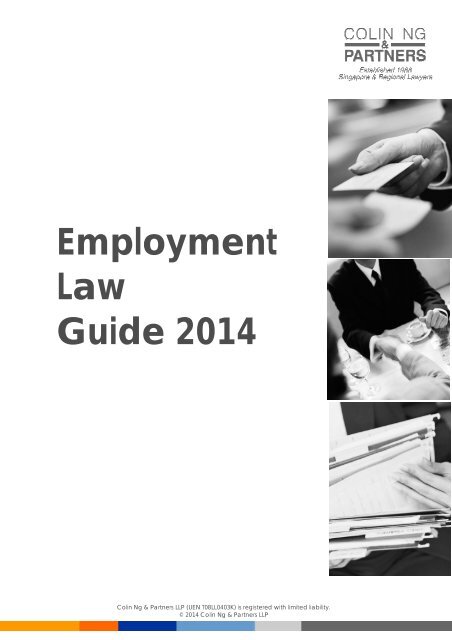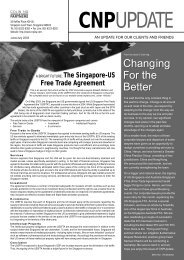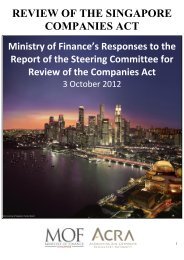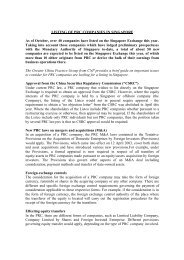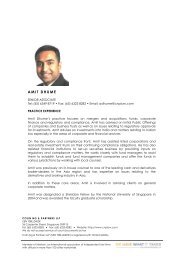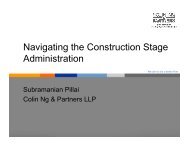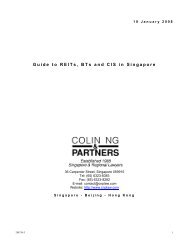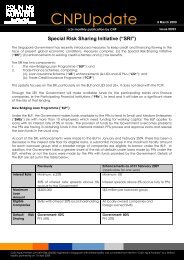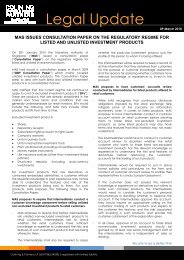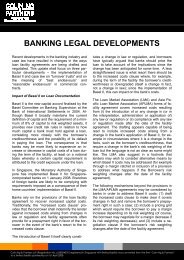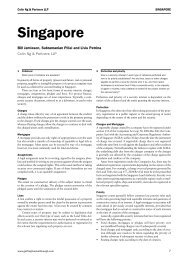Employment Law Guide - Colin Ng and Partners
Employment Law Guide - Colin Ng and Partners
Employment Law Guide - Colin Ng and Partners
Create successful ePaper yourself
Turn your PDF publications into a flip-book with our unique Google optimized e-Paper software.
CONTENTAn overviewThe <strong>Employment</strong> ActTermination of employment contracts <strong>and</strong> noticeSalaryOvertime EntitlementsSick leaveMaternity leaveRetrenchmentRetirementDisputes <strong>and</strong> Industrial relationsWorkplace Safety <strong>and</strong> Health ActEmployer’s tax considerationsCentral Provident FundNational Service leaveRestrictive covenants: Non-competition <strong>and</strong> non-solicitationConfidentiality <strong>and</strong> non-disclosure: Protection of Employer’s proprietaryinterests after termination of employmentMinistry of Manpower requirementsRevised Tripartite <strong>Guide</strong>lines on managing excess manpowerEA <strong>and</strong> CDCSA before <strong>and</strong> after the changes pursuant to the EPLOMAContact details34467789101011121314141617181821
An overviewThe relationship between employer <strong>and</strong> employee is regulated largely by thecontract of employment between them. Generally under Singapore law, partiesare free to contract as they choose <strong>and</strong> any matters arising between themwould have to be resolved by looking at either the express <strong>and</strong>/or implied termsof the contract in question. However, the law does impose certain limits on thisfreedom to contract.The sources of these limits include common law <strong>and</strong> statutes such as the<strong>Employment</strong> Act (Cap 91) ("EA"), first passed in 1968 <strong>and</strong> last amended on April 1,2014. The EA does not cover all the terms <strong>and</strong> conditions of a given employmentcontract, but rather it sets a minimum st<strong>and</strong>ard. Therefore, the terms of one'scontract of service must be at least equal to, or more favourable than theprovisions in the EA.Other pertinent statutes shaping employment law include the Workplace Safety<strong>and</strong> Health Act (“WSHA”), which came into effect on March 1, 2006; the ChildDevelopment Co-Savings Act (Cap 38A) (“CDCSA”); the Retirement <strong>and</strong>Re-employment Act (Cap 274A) (“RRA”); the Trade Unions Act (Cap 333) <strong>and</strong> theIndustrial Relations Act (Cap 136) (“IRA”); <strong>and</strong> the Income Tax Act (Cap 134).Additionally, employers should be aware of the Central Provident Fund Act (Cap36) <strong>and</strong> their monthly obligations to the Central Provident Fund (“CPF”), acomprehensive social security savings plan, as well as the <strong>Employment</strong> of ForeignManpower Act (Cap 91A) (“EFMA”), which regulates the terms <strong>and</strong> conditions forthe employment of foreign workers <strong>and</strong> is particularly relevant in the case offoreign workers who are not protected under the EA (e.g. foreign domesticworkers).PAGE 3In late 2012, the Singapore Ministry of Manpower embarked on an exercise toreview the EA to ensure that it remains relevant <strong>and</strong> responsive to the changinglabour market conditions <strong>and</strong> trends. The review of the EA was conducted in twoseparate phases. Phase 1 of the review was completed earlier in March 2013 <strong>and</strong>the <strong>Employment</strong>, Parental Leave <strong>and</strong> Other Measures Act (the “EPLOMA”) wassubsequently enacted on 12 November 2013 to amend various provisions in theEA with a majority of the amendments taking effect from 1 April 2014. Phase 2 ofthe review, which was focused on further protection of vulnerable workers,particularly those in non-traditional work arrangements (e.g. term contractworkers, outsourced workers <strong>and</strong> freelancers) <strong>and</strong> the EFMA, was closed inOctober 2013.Please note that the following guide is a summary, aimed at aiding underst<strong>and</strong>ingof Singapore employment law as at the date of writing. It is not exhaustive orcomprehensive <strong>and</strong> reading this memor<strong>and</strong>um is not a substitute for reading thetext of the various statutes to fully underst<strong>and</strong> the extent of the obligations owed.May 2014
2. The <strong>Employment</strong> Acttermination.PAGE 4(a) ScopeThe EA covers every employee (regardless ofnationality) who is under a contract of servicewith an employer, except:-any person employed in a managerial orexecutive position earning more than$4,500 basic monthly salary1;any seaman;any domestic worker; <strong>and</strong>any person employed by a Statutory Boardor the Government.Part IV of the EA, which provides for rest days,hours of work <strong>and</strong> other conditions of service,applies only to: workmen earning not more than $4,500basic month salaries; <strong>and</strong>non-workmen covered under the EA earningnot more than $2,500 basic monthlysalaries2;but it does not apply to persons employed in amanagerial or executive position.Employees working less than 35 hours a weekare covered by the <strong>Employment</strong> (Part-TimeEmployees) Regulations, which provide certainflexibility for both the employers <strong>and</strong> employees,including the pro-rating of employmentbenefits, encashment of annual leave <strong>and</strong>3provision of rest days.3. Termination of employment contracts <strong>and</strong>noticeThe provisions relating to termination are set outin Part II of the EA. Where the EA does notapply, the terms of the employment contractwill govern whether it can be terminated withoutcause <strong>and</strong> what period of notice must begiven. If there is no express term specifying theamount of notice required, a reasonableperiod of notice will be implied.The manner in which an employment contractmay be validly terminated will depend on theform of employment contract (which may beoral, written or partly oral <strong>and</strong> partly written)<strong>and</strong> its terms, which may be implied (bycustom or by statute) or express (which may beincorporated by reference, e.g. in the case ofan employee h<strong>and</strong>book <strong>and</strong> the terms of acollective agreement, if any). An employmentcontract may come to an end by expiry(where the specified term has elapsed or thespecified task or project is completed) or byFinally, termination agreements setting outagreed terms of the termination are common,particularly with executive staff. Provisionstypically set out termination payments(entitlements <strong>and</strong> negotiated payoutamounts), confidentiality/non-disclosureagreement <strong>and</strong> (where applicable) restrictivecovenants.(a) Termination without noticeWhere the EA applies, either party may terminatean employment contract without giving areason, <strong>and</strong> without notice, if the other partywilfully breaches a condition of the contract. Inaddition, under the EA, an employer is entitled(after due inquiry) to dismiss an employee withoutnotice on the grounds of misconduct. Forinstance, absence from work continuously formore than 2 days (a) without prior leave of theemployer or without reasonable excuse; or (b)without informing or attempting to inform theemployer of the excuse for the absence isdeemed to be a repudiatory breach by theemployee. Misconduct inconsistent with thefulfilment of the express or implied conditions ofhis service may be another ground for dismissingan employee without notice (after dueenquiry).(b) Termination by payment of salary in lieu ofnoticeA given contract may expressly provide thatemployment may be terminated by paymentof salary in lieu of notice.4However, even if notexpressly provided for, each party is entitled toterminate the contract without notice by givingpayment in lieu of notice. Additionally, an employeris entitled to terminate by notice referableto part of the total notice period togetherwith salary in lieu of notice referable to the restof the notice period.It is important to note that the right to terminatewithout notice is subject to Part II (Contracts ofService) of the EA.(c) Termination with noticeIf there is a notice period specified in theemployment contract, then notice is to begiven in accordance with it. Where the EAapplies, notice must be in writing <strong>and</strong> the dayon which it is given must be included in theperiod of the notice. Payment of alloutst<strong>and</strong>ing salary <strong>and</strong> any sum due is to bemade on the termination date or if this is notpossible then within 3 days of it.In the absence of any notice period specifiedin the employment contract <strong>and</strong> where the EAapplies, the following statutory minimum periodof notice is required:-
Length of serviceLess than 26 weeks26 weeks to less thantwo yearsTwo years to less thanfive yearsFive years <strong>and</strong> aboveMinimum noticeperiodOne dayOne weekTwo weeksFour weeks(f) BenefitsDepending on the terms of the employmentcontract, an employee may have an entitlementto payment on termination in relation to avariety of benefits, including an incentivescheme or annual cash bonus plan or executiveshare option scheme (“ESOS”).Where the contract is silent on the notice period<strong>and</strong> the EA does not apply, in a contractfor an unspecified term, a reasonable period ofnotice will be implied. In a contract for a fixedterm or a specified purpose, no such period ofnotice will be implied – these contracts cannotbe terminated on this basis.A party may waive his right to notice.Generally, there is no obligation on theemployer to provide work to the employee duringthe notice period save for certain rare5exceptions, such as where an employee'sposition might be deemed specific <strong>and</strong> unique,where his skills require frequent exercise to preserve<strong>and</strong> enhance them, <strong>and</strong> where barringthe employee from working would be inconsistentwith the express term of the contract.Where the general rule applies or if specificallyprovided for in the employment contract, it isopen to the employer to put the employee on“gardening leave” during that time, effectivelypreventing the employee from having contactwith clients.(d) Termination in cases of redundancy orreorganisationUnder the EA, there are no special requirementsin relation to the length of notice to beprovided in cases of termination for redundancyor reorganisation. The notice periodspecified in the contract or, in its absence, theminimum notice provisions applicable underthe EA, will apply (as discussed above).However, in cases of retrenchment, the Ministryof Manpower (“MOM”) encourages employersas far as possible to inform affected employeesof the impending retrenchment before noticeof retrenchment is given (see below).(e) Payment of accrued but unpaid salary up totermination date, accrued <strong>and</strong> unused annualleave <strong>and</strong> salary in lieu of notice <strong>and</strong>timing of payment on termination.Amounts for each of these (if applicable)should be paid on termination <strong>and</strong> specified inthe termination agreement if there is one.Where the EA applies, payment of alloutst<strong>and</strong>ing salary <strong>and</strong> any sum due to anemployee is to be made on the terminationdate or if this is not possible then within threedays of it.The terms of the contact may include paymentof health insurance, school fees <strong>and</strong> housingcosts. The exact terms need to be checked<strong>and</strong> payments or negotiated arrangements inrelation to relevant items dealt with in the terminationagreement.(g) Unfair dismissal by employerWhere the EA applies, if an employee considershe has been dismissed without just cause orexcuse, he may within one month of the dismissalmake representations in writing to theMinister to be reinstated. The Minister may inquireinto the reasons for the dismissal. The Ministermay direct the employer to:reinstate the employee <strong>and</strong> pay backwages referable to the time between termination<strong>and</strong> reinstatement; orpay, as compensation, an amount ofwages determined by the Minister insteadof ordering reinstatement. It would be prudentfor an employer to anticipate this byensuring that reasons are well documented<strong>and</strong> evidenced in line with modern HRpractices for continuing employee appraisal.The above applies to all EA employees not employedin a managerial or an executive position<strong>and</strong> to a manager or executive earningnot more than S$4,500 who have been workingfor that employer for at least 12 months in any6position.Where the EA does not apply, the terms of theemployment contract will determine whether itcan be terminated without reason. If there is nocontractual term permitting this, then the employercan terminate the contract without noticeor salary in lieu of notice provided the reasonis an act of the employee which amountsto a repudiation of the contract. If the employerterminates the contract without such areason, the employee may have an action forunfair dismissal.(h) Special considerations for terminating adirectorUnder section 152 of the Companies Act (Cap50) (“CA”), a public company may by ordinaryresolution remove a director before the expirationof his period of office, notwithst<strong>and</strong>ing any-PAGE 5
PAGE 6thing in the Memor<strong>and</strong>um or Articles of thecompany or any agreement between thecompany <strong>and</strong> the director.However, in the case of a director appointedto represent the interests of any particular classof shareholders or debenture holders, theresolution to remove him is ineffective until asuccessor has been appointed.Special notice must be given of a resolution toremove a director or to appoint a replacementdirector at the meeting at which he isremoved. At the meeting to remove him, thedirector is entitled to be heard on the resolution.A listed public company must give theSGX-ST (i.e., the relevant listing authority) noticeof receipt of a resolution to remove a director.In the case of private companies, section 152does not apply. Directors must be removed inaccordance with the company’s Memor<strong>and</strong>um<strong>and</strong> Articles <strong>and</strong>, in addition, in the caseof removal of an executive director, inaccordance with the termination provisions ofhis employment contract with the company.The resignation of removal of a director(whether pursuant to the termination of hisemployment in the case of an executivedirector or otherwise) will be deemed to beinvalid unless at least one director ordinarilyresident in Singapore (who may be the soledirector) will remain on the board, undersection 145(1) of the CA.The removal of a director must be notified toACRA through Bizfile within one month from thedate of his ceasing to hold the office.Legislation does not provide an employee withany right to retrenchment benefits on terminationfor redundancy or reorganisation of theemployer’s business. In fact, in the case of anemployee to whom Part IV of the EA applies(i.e. to a workman on a salary of $4,500 or lessper month or a non-workman employee whosesalary is not greater than $2,500 per month, ifthe employee has been employed for less than2 years (reduced from 3 years with effect from1 April 2015) continuously, the right to retrenchmentbenefits is specifically excluded undersection 45 of the EA. Even where an employeehas been continuously employed for 2 years ormore, then, pursuant to Singapore case law,7that employee still does not enjoy an automaticright to retrenchment benefits as an employerin Singapore has no legal obligation toprovide retrenchment benefits in such cases.Irrespective of whether the EA applies, an employeehas no right to retrenchment benefitsunless his or her employment contract or anapplicable collective agreement so provides.In cases where an employee is a trade unionmember, no trade union intervention/collectivebargaining is permitted in relation to terminationfor redundancy or reorganisation or in relationto the criteria for such termination, per section18(2)(d) of the IRA.3. Salary(a) PaymentUnder the EA, an employee must be paid atleast once a month. In general, an employer isrequired to pay his employees within seven8days after the end of the salary period.(i) Special considerations for makingemployees redundant or carrying out areduction in force (RIF), i.e. terminating anumber of employees at the same time,usually in connection with a reorganizationor consolidation of functions in thesame or a different officeLegislation does not provide an employee withany right to retrenchment benefits ontermination for redundancy or reorganizationof the employer’s business. In fact, in the caseof an employee to whom Part IV of the EAapplies (i.e. to a workman on a salary of $4,500or less per month or a non-workman employeewhose salary is not greater than $2,000 permonth), if he or she has been employed for lessthan 3 years continuously the right toretrenchment benefits is specifically excludedunder section 45 of the EA, <strong>and</strong> if employed for3 years or more then under Singapore case lawthere is no right to retrenchment benefits.Salary must be paid on a working day <strong>and</strong>during working hours at the place of work, or atany other place agreed to between theemployer <strong>and</strong> the employee. It may also bepaid into an employee's personal/joint bankaccount.(b) DeductionsEmployers may deduct salary only for reasonsallowed under the Act, or if ordered by theCourt. Such authorized deductions include thatfor absence from work, income tax payment,CPF contributions, etc.The maximum deduction amount in respect forany one salary period is 50% of the total salary.This does not include deductions for absencefrom work, payment of income tax, recovery ofloans <strong>and</strong> payments made with the consent ofthe employee. Within the 50% cap, deductionsfor accommodation, amenities <strong>and</strong> services
also may not exceed 25% of the employee’s9salary.hours of work <strong>and</strong> other conditions of service,applies only to:(c) Non-complianceThe failure to pay salary in accordance withthe EA constitutes an offence under the EA. Afirst-time offence will be liable to a fine of between$3,000 <strong>and</strong> $15,000 <strong>and</strong>/or 6 months' jail.A subsequent offence will be liable to a fine ofbetween $6,000 <strong>and</strong> $30,000 <strong>and</strong>/or 12 months'10jail. The maximum composition fine is $5,000.Individual officers <strong>and</strong> directors are accountablefor the offences committed by the company.In particular, officers who are primarilyresponsible for the non-compliance will be presumedto be negligent <strong>and</strong> held accountable11unless proven otherwise.<strong>Employment</strong> inspectors have the power toarrest, without warrant, any person whom hereasonably believes is guilty of the failure to12pay salary. They are also allowed to enter anyworkplace to conduct checks. However, MOMhas also clarified that the powers of inspectingofficers, with the enhanced penalties, are tobetter facilitate the enforcement of the EAprovisions <strong>and</strong> the arrest powers granted to theMOM officers are to be exercised in relation tothe minority of employers who are persistentlyuncooperative or who wilfully refuse to complywith orders to attend investigation sessions.(d) Work done during Public HolidaysEmployees under the EA are entitled to oneextra day’s salary on top of the day’s salary ifthey are required to work on a Public Holiday(or the day after a Public Holiday if the PublicHoliday falls on a rest day). Alternatively, theemployer may, by arrangement with theemployee, substitute the holiday with any otherday. workmen earning not more than $4,500basic monthly salaries; <strong>and</strong>non-workmen employees earning not morethan $2,500 basic monthly salariesGenerally, an employee covered under Part IVof the EA is not required to work more thaneight hours in a day or 44 hours in a week. He isalso not required to work more than six consecutivehours without a break. The duration of14the break should not be less than 45 minutes.Overtime allowance is payable if the employeeis required by the employer to work above thespecified limits of working hours in the EA. Anemployee is permitted to work up to a limit of72 hours of overtime in a month, excludingwork done within his normal daily working hours15on his rest day or public holiday.(b) Computation of Overtime PayAn employee must be paid at least 1.5 times hishourly basic rate of pay for all work in excess ofthe normal hours of work.The overtime rate payable for non-workmen iscapped at the salary level of $2,250; i.e. nonworkmenearning more than S$2,250 a monthwill be paid for overtime work at a rate based16on a salary of S$2,250.(c) Payment of Overtime EntitlementsPayment for overtime work must be madewithin 14 days after the last day of the salaryperiod.5. Sick LeavePAGE 7In addition, employees under the EA employedin a managerial or executive position, arepermitted, in lieu of the extra day’s salary or asubstituted day, any part of a day off on aworking day comprising such number of hoursas may be agreed between the employee <strong>and</strong>employer, in lieu of the extra day’s salary or asubstituted day, or if there is no such agreement,either 4 hours off if the employee worked4 hours or less on the Public Holiday or the13entire day if he worked more than 4 hours.4. Overtime Entitlements(a) EntitlementPart IV of the EA, which provides for rest days,(a) EntitlementAn employee covered by the EA is entitled topaid sick leave, including medical leave issuedby a dentist if:the employee has served the employer forat least three months;the employee has informed or attemptedto inform the employer of his/her absencewithin 48 hours; <strong>and</strong>the sick leave is certified by the company'sdoctor, or by a government doctor(including doctors from approved publicmedical institutions) if a company doctor is
PAGE 8not readily available (such as whencompany doctors are closed or very inconvenientlylocated), or during emergency17situations.This does not apply to any medical treatmentwhich is for cosmetic purposes.If the employee fails to duly notify or attempt tonotify the employer or if the sick leave is notduly certified, the employee will be deemed tobe absent from work without permission or reasonableexcuse.The number of days of paid sick leave anew employee is entitled to depends on hisservice period:No of monthsof servicecompleted ofa newemployee*An employee is deemed to be hospitalised ifhe/she is certified by a doctor to be in need ofhospitalisation. He does not necessarily have tobe warded in a hospital.(b) LimitMinimum PaidOutpatient SickLeave Entitlementper yearwhere hospitalisationis notrequired (days)3 months 5 15Minimum aggregatePaidSick LeaveEntitlement peryear wherehospitalisationis required*4 months 5 + 3 = 8 15 + 15 = 305 months 8 + 3 = 11 30 + 15 = 456 months 11 + 3 = 14 45 + 15 = 60Thereafter 14 60The amount of paid outpatient <strong>and</strong> hospitalisationsick leave that an employee can take iscapped at his sick leave entitlement (asindicated in the right-most column of the tableabove).(c) Reimbursement of medical expenses(d) Salary of employees on sick leaveIf an employee is on paid hospitalisation leave,his employer has to pay him at his gross rate ofpay. If an employee is on paid outpatient sickleave, his employer has to pay him at his grossrate of pay, excluding any allowance payable18in respect of shift work.(e) Sick leave on rest days, public holidays etc.An employee is not entitled to paid sick leaveon the following occasions, even if he is given amedical leave by the doctor:rest days;public holidays;non-working days;during annual leave;during no-pay leave.However, he is entitled to claim for the medicalexamination fee. His entitlement to claim forother medical expenses would depend on themedical benefits provided in his employmentcontract or the collective agreement signedbetween the company <strong>and</strong> the employee’sunion.6. Maternity Leave(a) EligibilityPart IX of the EA <strong>and</strong> Part III of the CDCSAprovide maternity protection <strong>and</strong> benefits foreligible employees.The CDCSA covers all parents of Singaporecitizens, including managerial, executive orconfidential staff. Under the act, an employeeis entitled to maternity leave benefits if:-the child is a Singapore citizen;If an employee has worked for at least threemonths, his employer is legally obliged to bearthe medical consultation fee except where themedical consultation is for cosmetic purposes.For other medical costs, such as medication,treatment or ward charges, the employer isobliged to bear such costs depending on themedical benefits provided for in theemployee's employment contract, or in thecollective agreement signed between thecompany <strong>and</strong> the union.the child's parents are lawfully married; <strong>and</strong>the employee has worked for the employerfor at least three months before the child's19birth.(b) Entitlement/durationA CDCSA eligible employee is entitled toabsent herself from work for:a period of four weeks immediately before<strong>and</strong> twelve weeks immediately afterdelivery; or
y agreement, a period of 16 weeks,beginning any time within 28 days prior toher confinement till the date of theconfinement; orby agreement a period of 8 weeks,beginning any time within 28 days prior toher confinement till the date of herconfinement, <strong>and</strong> such further period(s) ofan aggregate duration no shorter than theprescribed period under the CDCSA(equivalent to 8 weeks’ worth of workingdays) to be taken flexibly anytime, over the2012 month period following the child's birth.entitled to half the payment during the maternityleave, unless she can show sufficientcause that prevented her from giving suchnotice to the employer.If the employee qualifies for Government-paidmaternity leave under the CDCSA, she will bepaid by the employer during the entire 16weeks of maternity leave, regardless of thebirth order of the child. The employer is entitledto reimbursement from the Government for thelast eight weeks for the first <strong>and</strong> second confinements<strong>and</strong> all 16 weeks for the third or subsequentconfinements.Under Part IX of the EA, employees covered bythe EA, but not under the CDCSA, are entitledto:a total of 12 weeks of maternity leaveduring the period of 4 weeks before theconfinement <strong>and</strong> 8 weeks after theconfinement; orby agreement a total of 12 weeks ofmaternity leave commencing no earlierthan 28 days prior to the confinement; orby agreement with her employer, 8 weeksof leave beginning any time within 28days prior to her confinement till the dateof the confinement <strong>and</strong> such furtherperiod(s) of an aggregate duration noshorter than the prescribed period underthe EA (equivalent to 4 weeks’ worth ofworking days) to be taken flexibly anytimeover the 12 month period following the21child's birth.(c) SalaryUnder the EA, the employer is required tocontinue paying an employee her usual salary,i.e. her monthly gross rate of pay includingallowances, for the first eight weeks of maternityleave if:the employee has been employed for atleast 90 days before the date of delivery;the employee has less than two children ofher own at the time of delivery. In the caseof multiple births (e.g. twins, triplets etc)during the first pregnancy, the employer isstill required to pay the next eight weeks ofmaternity leave;the employee has given her employer atleast one week's notice before going onmaternity leave, <strong>and</strong> informed heremployer as soon as practicable of herdelivery. Otherwise, the employee is onlyIf the employee does not qualify for maternityleave under the CDCSA, payment beyond thefirst eight weeks is voluntary <strong>and</strong> subject to contractualagreement.(d) Employer’s obligationsEmployers are prohibited from dismissing anemployee who is on maternity leave. Anemployer who does so is liable to a fine <strong>and</strong>/orimprisonment.If a notice of dismissal is given without sufficientcause within six months of an employee'sconfinement, the employer must pay her thematernity benefits she is otherwise eligible for.If the employee is retrenched within threemonths of her confinement, the employer mustpay her the maternity benefits she is otherwisebe eligible for. This payment is in addition toany retrenchment benefit which the employeeis entitled to.An employer cannot employ an employee atany time during the four weeks immediatelyfollowing her confinement. An employer alsocannot contract out the maternity benefits.7. Retrenchment(a) BenefitsAn employee who has worked less than twoyears (reduced from three years with effectfrom 1 April 2015) in a company is not entitledto retrenchment benefits under the EA.However, an employee who has beenemployed in a company for at least two yearscan request for retrenchment benefits. As thelaw does not stipulate the quantum to be paid,the amount is subject to negotiation betweenthe employee <strong>and</strong> employer. Note additionallythat retrenchment benefits do not attract CPFcontributions.22PAGE 9
PAGE 10(b) Ex-gratia paymentsIn cases of termination for redundancy, anemployer may make an ex-gratia payment toan employee. However, under Singaporecommon law an employer is not bound tomake such a payment on the basis of its pastpractice of doing so.(c) Length of notice of terminationAs far as possible, affected employees shouldbe informed of the impending retrenchmentbefore notice of retrenchment is given. Theduration of notice will depend on what isstipulated in the contract of service. If thenotice period is not stipulated, the following willapply:Length of service Notice periodLess than 26 weeks 1 day26 weeks to less 1 weekthan 2 years2 years to less than 5 2 weeksyears5 years <strong>and</strong> above 4 weeksThe company is also advised to notify MOM ofany retrenchments.Notice can be given at any time, but it must bedated <strong>and</strong> given in writing. Either the employeeor the employer can choose to waive this rightto notice. Either party can also choose not towait for the notice period to expire. In this case,the party who does not wish to wait for theexpiry of the notice period must pay the othersalary in lieu of notice.Notice of termination need not be given ifthere has been a breach of the terms <strong>and</strong>conditions of the contract of service. Additionally,the employer need not give the employeenotice if he or she is absent from work for morethan 2 days without prior leave or withoutreasonable excuse or attempting to inform theemployer.8. Retirement(a) AgeThe RRA covers all employees who areSingapore citizens <strong>and</strong> permanent residents,including those in managerial, professional <strong>and</strong>executive positions, <strong>and</strong> makes it an offencefor an employer to dismiss an employee belowthe prescribed age on the grounds of age,notwithst<strong>and</strong>ing anything in any other writtenlaw, contract of service or collectiveagreement.The minimum age of retirement is 62 years. Anemployee can be retired the day before his/her 62nd birthday. However, if the retirementage is not specified in the employmentcontract, the employer should give theemployee advance notice as stipulated in thecontract. Employers are required to offerre-employment contracts of at least one year,renewable up to age 65. MOM, in its guidelines,has also advised employers to offer a threeyear re-employment contract until age 65 atone stretch.The RRA does not legislate compulsoryretirement; neither does it prohibit anemployee from continuing employmentbeyond the statutory retirement age. However,employees above age 62 are not covered bythe RRA, regardless of whether they areemployed on a contract or tenure basis. Thus,any extensions in an employee's employmentbeyond age 62 will be based on mutualagreement between the employer <strong>and</strong>employee.(b) BenefitsIrrespective of whether the EA applies, anemployee has no right to retrenchmentbenefits unless his or her employment contractor an applicable collective agreement soprovides.(c) DismissalThe RRA stipulates that employees who arebelow the prescribed retirement age cannotbe dismissed by their employers because of24their age. An employee will be deemed to bedismissed by the employer if:the contract under which he/she isemployed is terminated by the employer,regardless of whether or not notice is given;the employer retires the employee; orthe employer requires or causes theemployee to retire or resign because of his/her age.9. Disputes <strong>and</strong> Industrial relations(a) Dispute ResolutionIn individual cases, a Singapore employmentdispute which cannot be resolved amicablythrough conciliation could be referred to theCommissioner for Labour (Ministry of Manpower)(also known as the Labour Court, whichfunctions like a tribunal) for adjudication,provided the prescribed fee is paid <strong>and</strong> the23
claim satisfies the following criteria:of certain groups of government employees).26the employee is covered by the EA;(d) Collective agreementsthe claim must relate to matters arising noearlier than one year prior to the date oflodging the claim; <strong>and</strong>if the employee has left the employment,the claim must be lodged within 6 monthsof leaving the employment.Awards made by the Commissioner for Labour,for successful salary claims, will be capped at$20,000. An appeal can be made to the HighCourt, within 14 days of the decision or order ofthe Commissioner for Labour. Professionals <strong>and</strong>executives wishing to claim higher amounts willstill have to pursue their claims in the civil courtsthrough normal litigation.The Industrial Relations Act offers tripartitemediation conducted by a conciliation officerappointed by the Commissioner for Labour as adispute resolution mechanism to professionals,managers, <strong>and</strong> executive employeesearning not more than $4,500 a month<strong>and</strong> who are a member of a trade union whichhas not been recognised by the employer. Anemployer who fails to take part in the mediationcould be fined up to $5,000.(b) Industrial relations legislationIndustrial relations are relatively stable in Singapore- the country has been virtually strike-freefor decades. A key feature of Singapore industrialrelations is the concept of ‘tri-partism’,which refers to workers (through unions), employers(through employer organisations) <strong>and</strong>the government, through the MOM, workingtogether as collaborative partners.Freedom of association <strong>and</strong> representation isguaranteed to all employees in the privatesector by law. The main statutes are: the TradeUnions Act, which provides the formalities forthe establishment of a trade union, <strong>and</strong> theIRA, which sets out specific procedures for thenegotiation of collective agreements <strong>and</strong> theconciliation <strong>and</strong> arbitration of trade disputes.Under the IRA, collective agreements have tobe certified by the Industrial Arbitration Court(“IAC”). In this case, they are binding on theemployer (or its successor) <strong>and</strong> the relevanttrade union <strong>and</strong> its members. The term of thecollective agreement cannot be less than two27years <strong>and</strong> not more than three years. In theevent of a company restructuring, the collectiveagreement will remain valid for 18 monthsafter the date of transfer or until the expiry ofthe collective agreement, whichever is later.If a collective agreement is unable to beconcluded, the matter is referred to the IACwhich makes a determination on the dispute.Prior to referring to the IAC, parties may referthe matter for conciliation at the MOM to explorepossible mediated outcomes.(e) Industrial action <strong>and</strong> disputesThe Trade Unions Act allows any registeredtrade union to commence, promote, organiseor finance industrial action (including strikes),upon receipt of a majority consent of itsmembers, obtained through a secret ballot. Ingeneral, industrial actions are lawful inSingapore; however, once a trade uniondispute has been submitted to the IAC, anyindustrial action in connection with such a30dispute becomes prohibited.The IAC is empowered to resolve trade disputesthrough settlement <strong>and</strong> mediation proceedings.If the parties don’t reach an agreement,the IAC can issue orders (known as ‘awards’)which are final <strong>and</strong> binding <strong>and</strong> cannot bechallenged or appealed against. The awardsmay cover many aspects of industrial relations,including such matters as wages, bonuses,medical benefits, retirement or retrenchment31benefits, hours of work <strong>and</strong> overtime.10. Workplace Safety <strong>and</strong> Health ActThree fundamental principles supporting theOccupational Safety <strong>and</strong> Health (“OSH”)framework are:2829PAGE 11(c) Role of trade unionsThe major function of trade unions in Singaporeis to carry out collective bargaining, negotiateterms for collective agreements <strong>and</strong> to representmembers in resolving industrial disputes.Under the Trade Unions Act, trade unions must25register with the Registrar of Trade Unions. Anyperson above the age of 16 may be a memberof a registered trade union (with the exceptionreducing risks at their source by requiringstakeholders to eliminate or minimise therisks said sources create;instilling greater ownership (i.e., sense ofresponsibility) of safety <strong>and</strong> health outcomesby industry; <strong>and</strong>
PAGE 12preventing accidents through the impositionof higher penalties for poor safetymanagement.WSHA is the key legislation affecting thephilosophy of this OSH framework. The WSHAcovers all workplaces. The WSHA stipulates thatevery person must take “reasonably practicablesteps” to ensure the safety <strong>and</strong> health ofevery workplace <strong>and</strong> worker. It goes beyondthe prescriptive nature of the statute that itreplaced (the Factories Act) to:specify liabilities for a range of persons atthe workplace;focus (more) on workplace safety <strong>and</strong>health goals <strong>and</strong> systems; <strong>and</strong>stipulate greater penalties for actions thatcompromise employee safety <strong>and</strong> health.11. Employer’s tax considerations(a) Taxable incomeAll gains <strong>and</strong> profits derived by an employee inrespect to his employment are taxable, unlessthey are specifically exempt from income taxor are covered by an existing administrativeconcession. The gains or profits include allbenefits, whether in money or otherwise, paidor granted to an employee in respect of employment.Where employers also extend thebenefits to the employee's family members,relatives <strong>and</strong> friends, the benefits would be taxablein the h<strong>and</strong>s of the employee as a benefitfrom employment.(b) Required filingsPursuant to section 68(2) of the Income TaxAct, the employers are required to file with theInl<strong>and</strong> Revenue Authority of Singapore (“IRAS”)the following returns:- Form IR8A (Return of Employee’sRemuneration); Form IR8S (Details of Employer’s/Employee’s Contributions to CPF);Appendix 8A (Value of Benefits in Kind);<strong>and</strong>/orAppendix 8B (Value of Gains <strong>and</strong> Profitsfrom Stock Options)for all employees (who are employed in Singapore)by the 1st of March of each year.IRAS encourages all employers to join the Auto-Inclusion Scheme (“AIS”) for employment income,whereby employers submit their employees’income information to IRAS electronically.The employment income information will thenbe shown on the employees’ electronic taxreturn <strong>and</strong> automatically included in their incometax assessments.From the year of assessment 2014 onwards, theAIS is compulsory for all employers which have14 or more employees for the entire year endingthe relevant preceding year or have receivedthe "Notice to File <strong>Employment</strong> IncomeElectronically".(c) Flexible benefitsUnder the flexible benefits scheme, employeesare given a flexible benefits budget <strong>and</strong> canchoose their own benefits from a range ofbenefits.Offering benefits under the flexible benefitsscheme does not change the tax treatment ofthe benefits. That is, if an employee seeksreimbursement for an item that has beengranted concession or exempt from tax, thereimbursement is not taxable. However,reimbursement for an item that has not beengranted concession or exempt from tax istaxable. For example, reimbursement to anemployee for expenses incurred for medicaltreatment sought by the employee remains nottaxable even if the reimbursement is claimedunder the flexible benefits scheme. On theother h<strong>and</strong>, holiday reimbursement remainstaxable even if it is one of the items which anemployee can claim under the scheme.Hence an employer offering the flexiblebenefits scheme would have to make adistinction between taxable <strong>and</strong> non-taxablebenefits. The employer has to keep track of thetaxable items so that the taxable benefits arereported in the Form IR8A.(d) Withholding taxA non-resident is liable to pay income tax onSingapore-sourced income. Under the law,when a person makes payment of a specifiednature to a non-resident, he has to withhold apercentage of that payment <strong>and</strong> pay theamount withheld to IRAS.(e) Tax clearanceTax clearance is a process of ensuring that yournon-citizen foreign employee pays all his taxeswhen he ceases employment with you in Singaporeor plans to leave Singapore for more thanthree months. It is the responsibility of the em-
From 1 January 2015, the CPF contributionsfrom employers <strong>and</strong> employees will beincreased by 1.5% (i.e. 1% employer contribuployerto notify IRAS via FormIR21 <strong>and</strong> seek taxclearance for the affected foreign employees.An employer must seek tax clearance at leastone month before the non-citizen employee:-11. Central Provident Fund(a) Current contribution ratesceases to work for the employer inSingapore; oris on overseas posting; orleaves Singapore for any period exceedingthree months.An employer unable to give 1 month's noticemust state its reasons when seeking tax clearance.Note further that there is no requirement toapply for tax clearance for a permanentresident who intends to obtain another job inSingapore <strong>and</strong> not to leave Singapore permanently.Depending on the length of noticerequired under the employment contract, thetimeframe required for notifying IRAS mayrequire the employer to discuss the terminationwith the employee before notice is given tohim. In any discussion, the employer shouldmake it clear to the employee that theemployer will be required to obtain taxclearance <strong>and</strong> to withhold amounts owing tohim pending tax clearance.IRAS takes around 7 days to process anelectronically filed Form IR21 (21 days for apaper form). IRAS will then send a ClearanceDirective to the employer once the employee’stax liability is determined <strong>and</strong> a tax bill to theemployee.Tax clearance is not required for Singaporepermanent residents who are not leavingSingapore permanently after ceasingemployment with the employer. The employermay obtain a letter of undertaking at the pointof cessation if the employee has no intention toleave Singapore permanently. If there is to be atermination agreement, then as a practicalmatter it would be useful to have the undertaking<strong>and</strong> the termination agreement signed atthe same time.(f) PenaltiesContravention of any of the provisions of theIncome Tax Act is an offence <strong>and</strong> in the caseof a breach of the provisions referred to above(for which no penalty is expressly specified) afine not exceeding $1,000 is payable <strong>and</strong> indefault of payment the offence is punishableby imprisonment for a term not exceeding sixmonths.If the employee is a Singapore citizen or aSingapore permanent resident, contributions byboth the employer <strong>and</strong> the employee will needto be made to the CPF. The present rates are20% of the ordinary wages (up to a maximumof S$5,000 per month) from the employee <strong>and</strong>16% of the ordinary wages (up to a maximumof S$5,000 per month) from the employer foremployees who are up to 50 years of age <strong>and</strong>who are Singapore citizens or Singapore permanentresidents who have been Singapore32permanent residents for more than 2 years.The contributions for Singapore permanentresidents during the first two years of beingSingapore permanent residents are atgraduated rates to help them adjust to thelower take-home pay. The contribution ratesreduce on a graduated scale for employeeswho exceed 50 years of age. Ordinary wagesare generally the wages paid monthly, thewages due or granted wholly <strong>and</strong> exclusively inrespect of an employee’s employment in thatmonth. Contributions at the above rates alsoneed to be made in relation to additionalwages, for example, annual bonus which is notgranted wholly <strong>and</strong> exclusively for the monthbut at intervals of more than one month<strong>and</strong> may, for example, be paid yearly.However, the maximum amount of wagesincluding ordinary <strong>and</strong> additional wages onwhich contributions need to be made to CPF isS$85,000 which is equivalent to 17 months multipliedby the monthly CPF salary ceiling of33S$5,000 which applies to all age groups.(b) Increase in CPF contribution rates fromJanuary 2015Singapore’s 2014 Budget Statement, presentedon 21 February 2014, includes initiatives to raisethe CPF contribution rates from 1 January 2015.The purpose of the increase is to help providefor the future healthcare <strong>and</strong> retirement needsof employees. This will apply to SingaporeCitizens or Singapore Permanent Residents(“SPR”) from their third year of obtaining theSPR status <strong>and</strong> earning monthly wages of atleast S $750. As per current practice, theemployee contribution rates for employeesearning more than S$500 but less than S$750 willbe phased-in. The ordinary wage ceiling willremain unchanged, i.e. S$5,000.PAGE 13
Il terzo Oratorio Estivoa Simeri CrichiDomenica 8 luglio con la celebrazione della SantaMessa, a Simeri Crichi, si è concluso ufficialmente ilIII° Oratorio estivo. La messa ,presieduta dal Vescovomonsignor Vincenzo Bertolone, è stata celebrata in PiazzaFoibe,punto di riferimento centrale ,che ha visto aprirsi e chiudereogni giornata oratoriana, sotto lo sguardo di tantissimi spettatori.Alla funzione religiosa erano presenti il Prefetto di CatanzaroReppucci,il Com<strong>and</strong>ante della Compagnia dei Carabinieri capitanoDe Paola, il com<strong>and</strong>ante della Stazione dei carabinieri di SimeriCrichi Gigliotti, il Sindaco Marcello Barberio el’amministrazione comunale di Simeri Crichi , il Sindaco di SelliaSuperiore Davide Zicchinella,di Sellia Marina Amelio, di SoveriaSimeri Olivo, di Cropani Colosimo per rappresentare ibambini di questi paesi che hanno preso parte all’oratorio e numerosissimifedeli hanno partecipato rendendo gremita e giosa lapiazza .Accanto alle tante attività ludiche è stato accostato unpercorso spirituale centrato sui “dieci com<strong>and</strong>amenti” che accantoa don Luigi hanno curato altri sacerdoti: don FrancescoCristofaro , don Rosario Carrabetta ,Don Massimo Amelio, donGiuseppe Carrabetta ,don Raffaele ,i bambini, a fine giornata come verifica hanno reso sensibilmentevivo e tangibile quanto appreso con la realizzazione di piccoliplastici, scenette mimiche , balli e canti.Don Luigi ha accolto il Vescovo e lo ha ringraziato vivamenteper la sua presenza, ha inoltre ringraziato tutte le persone chehanno contribuito alla realizzazione dell’oratorio:animatori, tecnici,personale sanitario, vigilanza, gli sponsor Mangiatorellaed Edison.Il Vescovo ha dimostrato molto entusiasmo per la grossa partecipazionedei bambini,degli animatori e della popolazione tutta,compiaciuto soprattutto per il tema trattato perché ha affermatoche il rispetto dei com<strong>and</strong>amenti ,oltre all’elevazione spiritualefa costruire una sana società civile, infine ha esortato don Luigia proseguire l’attività oratoriale negli anni futuri. Sono inoltreintervenuti il Prefetto e il Sindaco di Simeri Crichi Barberio,iquali hanno dimostrato sensibilità e apprezzamento per questaesperienza che contribuisce sicuramente a costruire una societàmigliore ,il sindaco di Simeri Crichi Barberio ha espresso tuttala disponibilità a collaborare in sinergia con la Parrocchia in tuttele iniziative che l’infaticabile “regista” don Luigi mette in attoper il bene della comunità, compreso la costruzione della nuovachiesa che dovrebbe sorgere nei pressi di Piazza Foibe. La manifestazionesi è conclusa con una gr<strong>and</strong>e festa che ha coinvolto migliaiadi persone provenienti da tutto il comprensorio.Eugenio Gr<strong>and</strong>ePARROCCHIA MADONNA DI POMPEI:IL 40° PER RACCONTARELE MERAVIGLIE DI DIO !Due settimane (dal 6 al 20maggio 2012) intense di celebrazioni,riflessioni,eventiculturali, momenti di aggregazione, divera esperienza di comunione, hannocaratterizzato la ricorrenza del 40° anniversariodella fondazione della parrocchiaMadonna di Pompei.Il tema centrale attorno a cui si sonoarticolati i diversi interventi sia nelle liturgieche negli approfondimenti èstato La parrocchia comunità riscoprela sua vocazione e la sua missione allaluce della Parola e dell’Eucaristia. Imomenti culminanti sono stati quellipresieduti dai tre arcivescovi. La celebrazionedell’8 maggio ha vistola partecipazionedell’arcivescovometropolita monsignor Vincenzo Bertoloneche ha presieduto la liturgia eucaristicacon la celebrazione delsacramento della Cresima e la presenzadelle autorità e di numerosimembri del Comitato di Onore. Proprioil Presule ha esortato a proseguirenella scia tracciata dai pastori chehanno guidato questa comunità nell’annunciodel vangelo “sine glossa”sull’esempio di S. Francesco di Assisi.L’arcivescovo emerito monsignor AntonioCiliberti ha aperto, la domenica6 maggio, il cammino dei festeggiamentifocalizz<strong>and</strong>o come la Parola diDio genera la comunità e, con la forzadello Spirito, la nutre e la guida valorizz<strong>and</strong>ola diversità dei carismi e deiservizi. La domenica 20, l’arcivescovoemerito monsignor Antonio Cantisaniha concluso le celebrazioni esort<strong>and</strong>oa cogliere nell’impegno di ciascuno, secondoil proprio ruolo, nella comunitàecclesiale lo spazio e il luogo per costruireil nostro futuro di comunionecon Dio.Le persone e i volti che si sono succedutinelle diverse sere hanno apertouno spaccato di storia che è diventataun kairòs di Dio per i decenni trascorsi.Questi volti si sono intrecciati con l’artisticomosaico dell’abside rievoc<strong>and</strong>omomenti lieti e tristi, di grazie e di benedizionedel Signore che rendonosempre attuale la freschezza del vangelo.Il ricordo dei fratelli che ci hannolasciato e godono dal cielo la gioiasenza fine ( specialmente del compiantoarcivescovo monsignor Arm<strong>and</strong>oFares e di Padre Alfonso DiBartolo che hanno fondato la parrocchia)e gli incontri con i sacerdoti chehanno segnato la storia delle famigliedi questo territorio non ha risparmiatosentimenti ed emozioni forti. Ilritorno di P. Giorgio Andolfi, di P. GiuseppeSinopoli di P. Filippo Di Francia,P. Carlo Fotino, P. Aldo Mercurio,P.Amedeo Gareri, P. Michele Mazzeohanno fermato per un attimo il temoed hanno suscitato entusiasmo e ardoreper un impegnato sempre rinnovatoa testimoniare quella fede che daquesti ministri è stata custodita e curata.Tra gli eventi culturali non possiamonon ricordare la mostra dellibro, la mostra dei Santini e soprattuttoil concerto offerto dal coro Polifonicodel Santuario della madonnadella Consolazione di Reggio Calabriaaccompagnato da P. Giuseppe Sinopoliche ha lasciato nel cuore di tutti ungr<strong>and</strong>e messaggio di pace francescanae di armonia con tutte le creature. Leserate caratterizzate dal tono folkoristicocome la sagra, la cena etnica,l’animazione musicale degli OverSong hanno fatto da coronamento auna festa che ha coinvolto una comunitàche è pronta a ripartire in ascoltodel suo Signore per continuare a camminarenei sentieri della sua Parola edel dono dell’Eucaristia.I presupposti di questo camminosono stati già posti anche con la solennecelebrazione della Tredicina edella festa di S. Antonio nell’omonimachiesetta che è dato il nome al quartieree da cui l’impulso di evangelizzazioneè partito. E già nel mese diottobre si delineano due appuntamentiimportanti: il Rosario e la celebrazionedella Messa di Radio Maria e una tregiorni biblica sul tema Bibbia ed educazioneche vedrà come animatore P.Michele Mazzeo, docente di SacraScrittura presso l’Istituto teologico Calabro“S.Pio X”.Pino Silvestre1417 Luglio 2012
secret. This latter st<strong>and</strong>ard hinges on the identificationof some advantage or asset which canproperly be regarded as the employer'sproperty, <strong>and</strong> which it would be unjust to allowthe former employee to appropriate for his ownpurposes. This protection, however, cannot belegitimately claimed in respect of the skill, experience,know-how <strong>and</strong> general knowledgeacquired by an employee as part of his job42during his employment.Second, the agreement must not be widerthan is necessary to protect the interestconcerned. To ascertain whether the clause asdrafted is no wider that is reasonably necessaryto protect the legitimate interest of theemployer, the following factors are important:(a) Period of restraint: To be reasonable,the period of the restraint should not exceedthe period that is necessary for the protectionof the legitimate interests of the employer.merely technical <strong>and</strong> not part of the mainsubstance of the clause.”Furthermore, in such a case, the two clausesmust be intended to be two separate <strong>and</strong>independent obligations so that the partsevered does not change the meaning of thepart remaining.Public policyThere is one broad question: is it in the interestsof the community that this restraint should, asbetween the parties, be held reasonable <strong>and</strong>enforceable? This st<strong>and</strong>ard has hitherto primarilyreferred to anti-competitiveness. In one seminalcase, for instance, the Court held that agiven clause would be detrimental to thecommunity at large since it created a virtualmonopoly of a certain type of work in43Singapore on the part of the employer.PAGE 16The duration must not be longer than necessaryfor the protection of the employer’s interest;enough time to start a new employee at thetask <strong>and</strong> for the new employee to have areasonable opportunity to demonstrate hiseffectiveness to customers.The employee’s seniority, degree of influenceon the clients <strong>and</strong> access to confidentialinformation are relevant in judging whether theperiod of restraint is reasonable.(b) Geographical area: The rule withregard to the geographical area of a restrictiveclause is that the area should be co-extensivewith the protection of the legitimate interests ofthe employer.Thus, a restriction without geographical limit isgenerally not valid; an area must be clearlydefined.There must also be a connection betweencustomers <strong>and</strong> the defined area.The restrictions must be to countries or areas inwhich the employee had actual <strong>and</strong> significantcustomer contact.(c) Scope of activities prohibited: Arestraint in trade clause is not considered reasonableunless it is confined to protecting thelegitimate interest of the employer.Note that where the clause is considered toowide to be enforceable, it may be possible tosever the clause if “the part so enforceable isclearly severable, <strong>and</strong> even so, only in caseswhere the excess is of trivial importance or(d) Enforcement of restrictive covenantsThe two primary remedies available to anemployer who has suffered loss by reason of aformer employee’s breach are:injunction against said employee; <strong>and</strong>/ordamages to compensate for the injury orloss suffered. Note that as an alternative todamages, the remedy of an account ofprofits may in some instance be available.15. Confidentiality <strong>and</strong> non-disclosure: Protectionof Employer’s proprietary interestsafter termination of employment(a) Confidential informationAn employee has a duty of good faith duringthe course of employment. This includes animplied duty not to disclose confidentialinformation to persons who are not entitled toreceive it <strong>and</strong> not to make unauthorized use oftrade secrets or confidential information for hisown benefit.This obligation of non-disclosure or confidentialitycontinues after the employee has left theemployment of the employer. However theobligation is limited in scope after terminationof employment. Only in so far as theinformation is a trade secret or is highlyconfidential in nature so as to amount to atrade secret can the employee who has leftthe employment be restrained from disclosingor using it.An employee’s employment contract <strong>and</strong>/or a
termination agreement may provide that theduty of non-disclosure or confidentiality in relationto the employer’s confidential informationsurvives the term of the employment. A cleardefinition of confidential information should beincluded.For contractual restrictions on disclosure of anemployer’s confidential information to beenforceable:to hold a valid work pass before they can workin Singapore. Foreigners performing certain activitiesin Singapore for short durations may engagein these activities without a work passprovided they submit an e-notification to informMOM.There are various work passes an individual canapply for depending on the nature of theirwork.the information must be of such a naturethat the employer believes would be injuriousto him if it were released;the employer must believe that the informationis confidential or secret <strong>and</strong> is notalready in the public domain;Professionals – managerial, executive or specialisedjobs<strong>Employment</strong> Pass: Fixed monthly salary ofat least S$3,300 <strong>and</strong> acceptable qualifications.Must be cancelled on termination ofemployment.the employer’s belief above must bereasonable; the information must be judged in the lightof the usage <strong>and</strong> the practices of theparticular industry; <strong>and</strong>Personalised <strong>Employment</strong> Pass: granted toexisting EP holders, granted on applicant’smerit <strong>and</strong> not tied to employer.EntrePass: For foreign entrepreneurs intendingto start a business in Singapore.the employer must limit the disseminationof the information <strong>and</strong> not encourage itswidespread publication.(b) Duration of a non-disclosure or confidentialityobligationThere is no specified legal limit to the durationof a confidentiality obligation binding on anemployee after termination of employment. Onan application for an injunction restraining thebreach of a non-disclosure or confidentialityobligation, if the court's view was that the protectedinformation had lost its quality of confidencewith the passing of time or it was alreadyin the public domain, then it would notgrant an injunction restraining disclosure.If the court took the view that the informationought to continue to be protected but for alimited time, then it could grant an injunction toprohibit disclosure for a specified further period,based on what it considered reasonable in theparticular circumstances. A confidentiality ornon-disclosure clause would not be void if itwas for an indefinite period or for a period thecourt considered excessive, but it would beenforced only for the period the court held wasreasonable. In certain circumstances restraintfor an indefinite period may be reasonable.16. Ministry of Manpower requirements(a) Work pass requirementsNon Singapore resident individuals are requiredMid-level – e.g. techniciansS Pass: Applicable to mid-level skilled workerswho earn a fixed monthly salary of atleast $2,200. Applicants are assessed baseson salary, education, skills, job type <strong>and</strong>work experience.Skilled & Semi Skilled workers – workers from an44approved source country/territoryOthersWork Permit: Issued to foreign unskilledworkers generally for 2 years depending onworker’s passport validity, Banker’s/Insurance Guarantee, worker’s employmentperiod.Dependant’s pass: Issued to legally marriedspouse or unmarried children under 21years of EP or S Pass holders.Long Term Visit pass: EP <strong>and</strong> S Pass holdersearning at least $4,000 can apply for a LTVpass for their spouse, unmarried step childrenor unmarried h<strong>and</strong>icapped childrenabove 21 years.The <strong>Employment</strong> of Foreign Manpower (WorkPasses) Regulations 2012, effective as of 3 September2013, provide that work passes(whether work permit (including a training workpermit), S pass, employment pass (including atraining employment pass), any of which maybe relevant to an employer) may be cancelledPAGE 17
on application to the Controller of Work Passes(“Controller”) made (a) by the employer of theforeign employee or on behalf of the employerby an authorised representative, <strong>and</strong> (b) insuch form <strong>and</strong> manner as the Controller may45determine.The MOM guidelines indicate that: a work pass must be cancelled within 7days of the date of termination of employmentby either the employer or an authorisedrepresentative of the employer. Thecancellation may be completed electronicallythrough WP Online, in the case of awork permit (including a training workpermit), or through EP Online, in the case ofan S pass or an employment pass(including a training employment pass),both accessible through the website of theMOM;the MOM will issue a 30-day short term visitpass upon cancellation of an S pass or anemployment pass (including a trainingemployment pass) to enable the passholder to prepare for his/her departurefrom Singapore;of Singaporeans at the professional, managerial<strong>and</strong> executive level compared to others inthe same industry or have repeated complaintsof nationality-based or other discriminatory hiringpractices). If firms are not responsive towardsimproving their recruitment <strong>and</strong> trainingpractices, MOM may impose additional requirements.These firms may expect greatersecurity <strong>and</strong> a longer review period for theiremployment pass applications <strong>and</strong> may alsohave their work pass privileges curtailed.17. Revised Tripartite <strong>Guide</strong>lines onmanaging excess manpowerCertain guidelines agreed by tripartite partnersthe MOM, National Trades Union Congress(“NTUC”) <strong>and</strong> Singapore National EmployersFederation (“SNEF”) state that employer companiesshould notify the MOM of impendingretrenchments as soon as possible if a decisionto this effect has been made <strong>and</strong> that as far aspossible employing companies should informaffected workers of their impending retrenchmentbefore notices of retrenchment aregiven.PAGE 18when the main employment pass or S passis cancelled, all other related passes (i.e.dependant's pass <strong>and</strong>/or long term visitpass) are deemed cancelled. Thedependant's pass <strong>and</strong>/or long term visitpass may be cancelled along with themain employment pass or S pass electronicallythrough EP Online.Note that the guidelines are not m<strong>and</strong>atory butamount to strong recommendations to employers.Employers should follow the guidelines setout in the relevant paragraphs to the extent it ispractical to do so taking account of the requirementsof their business.(b) Fair <strong>Employment</strong> PracticesEffective 1 August 2014, firms submitting employmentpass applications are required to advertisethe job vacancies on a jobs bank administeredby the Singaporean Workforce DevelopmentAgency for 2 weeks before opening theposition up to foreigners. The advertisementshave to comply with the Tripartite <strong>Guide</strong>lines onFair <strong>Employment</strong> Practices <strong>and</strong> should avoidstating a preference for age, race, language,gender, marital status <strong>and</strong> religion.18. EA <strong>and</strong> CDCSA before <strong>and</strong> after thechanges pursuant to the EPLOMAThe salient changes made to the EA <strong>and</strong>CDCSA pursuant to the amended EA whichtook effect on 1 April 2014 are tabulated below:(refer to next page)However, small firms with 25 or fewer employees<strong>and</strong> jobs which pay a fixed monthly salary of$12,000 <strong>and</strong> above will be exempted from theadvertising requirements, unless MOM receivescomplaints of nationality-based or other discriminatoryHR practices.MOM <strong>and</strong> other government agencies will alsoidentify businesses which, in their view, havescope to improve their hiring practices (e.g.firms with disproportionately low concentration
Sections Before 1 April 2014 From 1 April 2014<strong>Employment</strong> ActApplicability of the EA to employeesin professional, managerial or executivepositions (“PMEs”) receiving salarynot exceeding S$4,500Not covered by the EA, except fora few provisionsThe entire EA, except for Part IV(Rest Days, Hours of Work <strong>and</strong>Other Conditions of Service) appliesSection 2(2)Overtime paymentsSection 38(6) <strong>and</strong> new Fourth ScheduleNon workmen employees earningup to S$2,000 can claim overtimepayNon workmen earning up toS$2,500 can claim overtime paybut the overtime rate payable fornon-workmen will be capped atthe salary level of S$2,250Unfair dismissalSection 14PMEs terminated in accordancewith terms of their contacts haveno recourse even if they believethey have suffered unfair dismissalPMEs (along with all other EA employees)who have served theiremployers for 12 months canhave their claims addressedwhether they have been dismissedwith or without noticeDeductions for accommodation,amenity <strong>and</strong> serviceSection 30Total deductions not to exceed50% of salaryDeductions for accommodation,amenities <strong>and</strong> services shall notexceed the 25% sub-cap of thetotal 50% capEnforcement of <strong>and</strong> compliance withemployment st<strong>and</strong>ardsSection 53Penalty for failure to pay salary forfirst time offenders a fine not exceedingS$5,000 <strong>and</strong> for a secondor subsequent offence to a finenot exceeding S$10,000 or to imprisonmentfor a term not exceeding12 months or bothA first time offence will be liable toa fine of between S$3,000 <strong>and</strong>S$15,000 <strong>and</strong>/or 6 months’ jail. Asubsequent offence will be liableto a fine of between S$6,000 <strong>and</strong>S$30,000 <strong>and</strong>/or 12 months’ jail<strong>Employment</strong> inspector power toarrest person guilty of failure topay salary <strong>and</strong> allowed to enterworkplace to conduct checksPAGE 19RetrenchmentSection 45An employee who has workedless than three years in a companyis not entitled to retrenchmentbenefits under the EAReduced two 2 years with effectfrom 1 April 201516 weeks flexible maternity leaveSection 9Child Development Co-Savings ActEmployee may with agreementof employer take a period of 8weeks any time within 28 days ofher confinement till the date ofthe confinementThe extended duration will be forsuch period as agreed betweenthe employee <strong>and</strong> her employerbut in aggregate no shorter than48 days or the number of days tobe computed according to thenew formulae set out in theschedule to the CDCSA, whicheveris shorterNote: This information is provided to you for youradvice.general information <strong>and</strong> should not be relied upon as legal
Note:PAGE 201. Section 2(1), <strong>Employment</strong>, Parental Leave <strong>and</strong> Other Measures Act, which deletes <strong>and</strong> substitutes Section 2(2), <strong>Employment</strong> Act2. Section 2(10), <strong>Employment</strong>, Parental Leave <strong>and</strong> Other Measures Act, which amends Section 33(1)(b), <strong>Employment</strong>Act3. Regulation 66B, <strong>Employment</strong> (Part-Time Employees) Regulations, <strong>Employment</strong> Act4. Section 11, <strong>Employment</strong> Act5. William Hill Organisation Ltd v Tucker [1999] ICR 2916. Section 2(2)(b), <strong>Employment</strong>, Parental Leave <strong>and</strong> Other Measures Act, which amends Section 14, <strong>Employment</strong>Act7. Bethlehem Singapore Pte Ltd v. Ler Hock Seng <strong>and</strong> Others [1995] 1 SLR 1, Loh Siok Wah v. American InternationalAssurance Co Ltd [1999] 1 SLR 2818. Sections 20(1) <strong>and</strong> 21(1), <strong>Employment</strong> Act9. Section 2(7), <strong>Employment</strong>, Parental Leave <strong>and</strong> Other Measures Act, which repeals <strong>and</strong> substitutes Section 30,<strong>Employment</strong> Act10. Section 2(11), <strong>Employment</strong>, Parental Leave <strong>and</strong> Other Measures Act, which amends Section 34, <strong>Employment</strong>Act11. Ibid12. Section 2(20), <strong>Employment</strong>, Parental Leave <strong>and</strong> Other Measures Act, which introduces a new Section 105,<strong>Employment</strong> Act13. Section 2(17), <strong>Employment</strong>, Parental Leave <strong>and</strong> Other Measures Act, which amends section 88, <strong>Employment</strong>Act14. Section 38, <strong>Employment</strong> Act15. Sections 38(4) <strong>and</strong> 38(5), <strong>Employment</strong> Act16. Section 2(13), <strong>Employment</strong>, Parental Leave <strong>and</strong> Other Measures Act, which amends section 38(6), <strong>Employment</strong>Act <strong>and</strong> Section 2(29) which includes a new Fourth Schedule (Employee’s hourly basis rate of pay forcalculation of payment due for overtime) to the <strong>Employment</strong> Act17. Section 89(1), <strong>Employment</strong> Act18. Section 89(5), <strong>Employment</strong> Act19. Section 3(9a), Child Development Co-Savings Act20. Section 9(1)(b) <strong>and</strong> 9(1)(c), Child Development Co-Savings Act21. Section 76(1)(c), <strong>Employment</strong> Act22. Section 45, <strong>Employment</strong> Act23. Section 4(1), Retirement <strong>and</strong> Re-employment Act24. Section 8, Retirement <strong>and</strong> Re-employment Act25. Section 7(3), Trade Unions Act26. Section 28, Trade Unions Act27. Section 25(5), Industrial Relations Act28. Section 4, <strong>Employment</strong>, Parental Leave <strong>and</strong> Other Measures Act, which amends Section 25, Industrial RelationsAct29. Section 35(1), Industrial Relations Act30. Section 27(9), Trade Unions Act31. Section 37, Trade Unions Act32. First Schedule” of the Central Provident Act33. Ibid34. Section 23(1) of the Enlistment Act35. Section 25(1) of the Enlistment Act36. Stratech Systems Ltd v Nyam Chiu Shin (alias Yan Qiuxin & Ors) [2005] 2 SLR 57937. Buckman Laboratories (Asia) Pte Ltd. V Lee Wei Hoong [1999] 3 SLR 33338. Asiawerks Global Investment Group Pte Ltd v Ismail Bin Syed Ahmad [2004] 1 SLR 23439. [2010] SGCA 340. Stratech Systems Ltd41. Heller Factoring (Singapore) Ltd v. <strong>Ng</strong> Tong Yang [1998] 3 SLR 29942. Stratech Systems Ltd43. Thomas Cowan & Co Ltd v Orme [1961] MJL 4144. North Asia Sources (NAS) – Hong Kong, Macau, South Korea <strong>and</strong> TaiwanNon-Traditional Sources – India, Sri Lanka, Thail<strong>and</strong>, Bangladesh, Myanmar <strong>and</strong> Philippines PRC45. Sections 4(7), 5(2) <strong>and</strong> 6(4), <strong>Employment</strong> of Foreign Manpower Act (Work Passes) Regulations 2012
CONTACT DETAILSBill JAMIESONPartnerbilljamieson@cnplaw.com+65 6349 8680Pradeep Kumar SINGHPartnerpksingh@cnplaw.com+65 6349 8697PAGE 21<strong>Colin</strong> <strong>Ng</strong> & <strong>Partners</strong> LLP36 Carpenter StreetSingapore 059915T: +65 6323 8383F: +65 6323 8282E: contact@cnplaw.com


